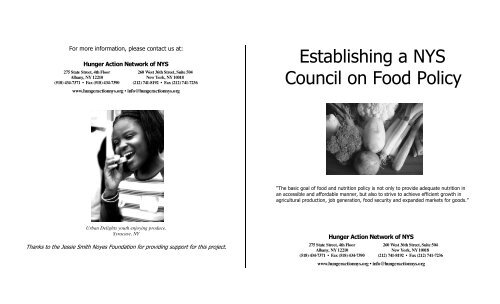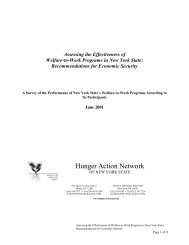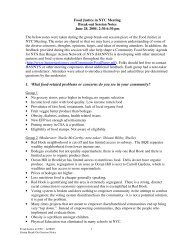Establishing a NYS Council on Food Policy - Hunger Action Network ...
Establishing a NYS Council on Food Policy - Hunger Action Network ...
Establishing a NYS Council on Food Policy - Hunger Action Network ...
- No tags were found...
You also want an ePaper? Increase the reach of your titles
YUMPU automatically turns print PDFs into web optimized ePapers that Google loves.
275 State Street, 4th FloorAlbany, NY 12210(518) 434-7371 • Fax (518) 434-7390260 West 36th Street, Suite 504New York, NY 10018(212) 741-8192 • Fax (212) 741-7236www.hungeracti<strong>on</strong>nys.org • info@hungeracti<strong>on</strong>nys.org !"#$ % & ' (Urban Delights youth enjoying produce.Syracuse, NY 275 State Street, 4th FloorAlbany, NY 12210(518) 434-7371 • Fax (518) 434-7390260 West 36th Street, Suite 504New York, NY 10018(212) 741-8192 • Fax (212) 741-7236www.hungeracti<strong>on</strong>nys.org • info@hungeracti<strong>on</strong>nys.org
Dear <strong>Hunger</strong> Acti<strong>on</strong> <strong>Network</strong> Supporter,This fall we will elect a new Governor and all the members of the statelegislature. It is urgent that we all make a c<strong>on</strong>certed effort to educate our legislatorsabout the importance of the <str<strong>on</strong>g>NYS</str<strong>on</strong>g> <strong>Food</strong> <strong>Policy</strong> <str<strong>on</strong>g>Council</str<strong>on</strong>g> (FPC) so they will place it high<strong>on</strong> their list of priorities for next year. We must also c<strong>on</strong>tinue to educate ourselves andour communities about the role the <strong>Food</strong> <strong>Policy</strong> <str<strong>on</strong>g>Council</str<strong>on</strong>g> could play <strong>on</strong> issues such ashunger, poverty, nutriti<strong>on</strong>, envir<strong>on</strong>mental protecti<strong>on</strong> and sustainable agriculture.A <str<strong>on</strong>g>Council</str<strong>on</strong>g> <strong>on</strong> <strong>Food</strong> <strong>Policy</strong> would have a variety of benefits for New York. Ithas as its starting point the food and health needs of low-income communities but italso addresses a broad range of problems affecting our entire food system:disappearing farmland and inner city supermarkets, increasing poverty and hunger,diminishing family farms, ec<strong>on</strong>omic opportunity, community development, theenvir<strong>on</strong>ment, rural community disintegrati<strong>on</strong>, inadequate green space, and diet-relatedhealth problems.We cannot end hunger without a str<strong>on</strong>g local agricultural system. This bookletoutlines the c<strong>on</strong>cept of community food security and how the <strong>Food</strong> <strong>Policy</strong> <str<strong>on</strong>g>Council</str<strong>on</strong>g>would assist with promoting community food security. A <strong>Food</strong> <strong>Policy</strong> <str<strong>on</strong>g>Council</str<strong>on</strong>g> didexist during the Cuomo administrati<strong>on</strong>. Re-establishing it has received bipartisansupport as well as the endorsement of the <str<strong>on</strong>g>NYS</str<strong>on</strong>g> Farm Bureau, dietetic groups, antihungerorganizati<strong>on</strong>s and sustainable agriculture groups.Democratic candidates:C<strong>on</strong>tact Informati<strong>on</strong> for Gubernatorial CandidatesEliot Spitzer Thomas Suozzi330 Madis<strong>on</strong> Avenue Friends of Tom Suozzi19th Floor P.O. Box 112New York, NY 10017 Carle Place, NY 11514Ph<strong>on</strong>e: 212.529.2006 Ph<strong>on</strong>e: (516) 741-5315Fax: 212.979.2607Email: Spitzer@spitzer2006.comRepublican candidate Libertarian candidateJohn Faso John Clift<strong>on</strong>Friends of John Faso 2006 Elect Clift<strong>on</strong> Inc.P.O. Box 10278 165-90 Baisley Blvd., #415Albany, NY 12201 Jamaica, NY 11434Ph<strong>on</strong>e: (518) 465-2006 Ph<strong>on</strong>e: (877) 769-4014Fax: (518) 465-2007 Electclift<strong>on</strong>@spamarrest.cominfo@johnfaso.comGreen Party candidateMalachy McCourtPh<strong>on</strong>e: (631) 587-2911rhill3@opt<strong>on</strong>line.net1.10.
TAKE ACTION NOW!• C<strong>on</strong>tact the gubernatorial candidates and tell them we need a <str<strong>on</strong>g>Council</str<strong>on</strong>g> <strong>on</strong><strong>Food</strong> <strong>Policy</strong>! The New York State 2006 gubernatorial electi<strong>on</strong> is November7 th . C<strong>on</strong>tact informati<strong>on</strong> and a sample letter are included.• Fill out the enclosed form to sign <strong>on</strong>to the Community <strong>Food</strong> SecurityLegislative Agenda for <str<strong>on</strong>g>NYS</str<strong>on</strong>g>. Please fax it back to (518) 434-7371 or mail it to:<strong>Hunger</strong> Acti<strong>on</strong> <strong>Network</strong> of <str<strong>on</strong>g>NYS</str<strong>on</strong>g>, 275 State Street, Albany, NY 12210• Have your organizati<strong>on</strong> join a statewide coaliti<strong>on</strong> to receive updates andcoordinate activities <strong>on</strong> the <strong>Food</strong> <strong>Policy</strong> <str<strong>on</strong>g>Council</str<strong>on</strong>g> & other CFS issues. We willhave m<strong>on</strong>thly or bi-m<strong>on</strong>thly c<strong>on</strong>ference calls starting this fall. EmailDunleamark@aol.com to join!• Send the attached CFS sign-<strong>on</strong> form to your State Senator andAssemblypers<strong>on</strong>. To find out who represents you, go to www.vote-smart.org orc<strong>on</strong>tact <strong>Hunger</strong> Acti<strong>on</strong>.• Educate others about the purpose of a <str<strong>on</strong>g>Council</str<strong>on</strong>g> <strong>on</strong> <strong>Food</strong> <strong>Policy</strong>.• Join our listserv to receive up to date informati<strong>on</strong> about the FPC and otherlegislative items. Email Dunleamark@aol.com to join.• Download our Community <strong>Food</strong> Security Report, which provides furtherdetails <strong>on</strong> Community <strong>Food</strong> Security and the <strong>Food</strong> <strong>Policy</strong> <str<strong>on</strong>g>Council</str<strong>on</strong>g>. Go to:www.hungeracti<strong>on</strong>nys.org• Become a member of <strong>Hunger</strong> Acti<strong>on</strong>!What is Community <strong>Food</strong> Security?According to the United Nati<strong>on</strong>s’ <strong>Food</strong> and Agriculture Organizati<strong>on</strong>, “food securitymeans that food is available at all times; that all pers<strong>on</strong>s have means of access to it;that it is nutriti<strong>on</strong>ally adequate in terms of quantity, quality and variety; and that it isacceptable within the given culture. Only when all these c<strong>on</strong>diti<strong>on</strong>s are in place can apopulati<strong>on</strong> be c<strong>on</strong>sidered food secure”.<strong>Food</strong> for Growth in Buffalo points out that ensuring food security differs from thec<strong>on</strong>cept of feeding the hungry. Emergency food programs (EFPs) are a short-termmeasure that <strong>on</strong>ly treats the symptom of a societal problem. <strong>Food</strong> security in c<strong>on</strong>trastrequires proactive steps to create a community food system that enhances citizens’access to nutritious and affordable food at all times.In a community food system, food is grown, produced, processed and disposed at alocal level. Since locally produced and distributed food reduces dependence <strong>on</strong> l<strong>on</strong>gdistancefood sources, a community food system increases community self–sufficiency. A community food system has the potential to promote ecologicallyfriendly food cultivati<strong>on</strong> methods and encourage community development. Such asystem can also have a significant impact <strong>on</strong> ec<strong>on</strong>omic development because it createslocally based employment and provides opportunities for people to raise themselvesout of poverty.According to the Community <strong>Food</strong> Security Coaliti<strong>on</strong>, the term Community <strong>Food</strong>Security was developed in 1994 by advocates seeking comprehensive soluti<strong>on</strong>s to thenati<strong>on</strong>'s food and farming crises. It integrates many different fields, such as publichealth, ecology, community development and ec<strong>on</strong>omic development into acomprehensive framework for meeting a community's food needs.9.2.
There are five basic principles to Community <strong>Food</strong> Security (CFS):Low-Income. CFS focuses <strong>on</strong> meeting the food needs of low-income communities. Inadditi<strong>on</strong> to providing food to the hungry, it includes job training, business skilldevelopment, urban greening, farmland preservati<strong>on</strong>, and community revitalizati<strong>on</strong>.Community sustainability. CFS builds up a community's food resources to meet itsown needs. These resources may include supermarkets, farmers'markets, gardens,transportati<strong>on</strong>, community-based food processing ventures, and urban farms.Self-reliance/empowerment. CFS seeks to build individuals'abilities to provide fortheir own food needs.Local agriculture. CFS builds better links between farmers and c<strong>on</strong>sumers, helping tostrengthen c<strong>on</strong>sumer knowledge and c<strong>on</strong>cern about their food source.<strong>Food</strong> system. CFS emphasizes collaborati<strong>on</strong> am<strong>on</strong>g many partners involved infarming, processing, distributing, marketing and c<strong>on</strong>suming food products.Some key problems that a <strong>Food</strong> <strong>Policy</strong> <str<strong>on</strong>g>Council</str<strong>on</strong>g> should address:Lack of Availability of nutritious foodA lack of supermarkets with fresh fruits, vegetables, and meat Community members are forced to cut back <strong>on</strong> food porti<strong>on</strong>s or skip mealsIndividuals and families are dependent <strong>on</strong> emergency food programs (EFPs) or soupkitchens and food pantries<strong>Food</strong> pantries and soup kitchens are overwhelmed and overextendedCulturally appropriate food is inaccessible to ethnic and immigrant groupsProblems accessing <strong>Food</strong> Stamps or using <strong>Food</strong> Stamps Electr<strong>on</strong>ic BenefitsTransfer (EBT) cards at farm stands, farmers’ markets, or food buying clubsNot enough adequate community gardening projects3.Summary of <str<strong>on</strong>g>NYS</str<strong>on</strong>g> <str<strong>on</strong>g>Council</str<strong>on</strong>g> <strong>on</strong> <strong>Food</strong> and Nutriti<strong>on</strong> <strong>Policy</strong> BillA <strong>Food</strong> <strong>Policy</strong> <str<strong>on</strong>g>Council</str<strong>on</strong>g> bill for <str<strong>on</strong>g>NYS</str<strong>on</strong>g> (A10461/S7618) has been introduced by As.Felix Ortiz. Senator Cathy Young introduced the bill in the Senate. Summary:To establish a State food policy council to develop comprehensive, coordinated statefood policies with the goal of providing a plentiful, accessible, affordable, safe andnutritious food supply, comprised of locally produced foods as much as possible, sothat all citizens of the State are able to eat a healthy diet and avoid hunger and have theopportunity to support a vibrant local farm and food ec<strong>on</strong>omy.The <str<strong>on</strong>g>Council</str<strong>on</strong>g> would c<strong>on</strong>sist of the Commissi<strong>on</strong>ers or Directors of: Health, Agriculture& Markets, Temporary & Disability Assistance, Educati<strong>on</strong>, Aging, Children & FamilyServices, General Services, Ec<strong>on</strong>omic Development, Labor, Transportati<strong>on</strong>,Envir<strong>on</strong>mental C<strong>on</strong>servati<strong>on</strong>, State Emergency Management, and others. Establish anAdvisory Board to the <str<strong>on</strong>g>Council</str<strong>on</strong>g> of at least 15 members representing the issue areas ofagriculture, anti-hunger, nutriti<strong>on</strong>, food businesses, and labor.The <str<strong>on</strong>g>Council</str<strong>on</strong>g> would report every December <strong>on</strong>: the prevalence of hunger and foodinsecurity, the nutriti<strong>on</strong>al well-being of various populati<strong>on</strong> groups, and the status ofagriculture and the food industry in the State. The report would includerecommendati<strong>on</strong>s of state policies and acti<strong>on</strong>s to meet the following goals: reducinghunger by providing affordable, nutritious food, from local producers wheneverpossible; the adopti<strong>on</strong> of diets by New Yorkers that promote health and preventdisease, using foods from local producers whenever possible; increased c<strong>on</strong>sumerdemand for New York farm products; a profitable food producing system whichmaximizes producti<strong>on</strong> of nutritious foods, protects the envir<strong>on</strong>ment, and providessufficient income for farm families and farm workers; ec<strong>on</strong>omic viability for foodprocessing, marketing and distributi<strong>on</strong> industries; and, increased effectiveness andcoordinati<strong>on</strong> of food, farm and nutriti<strong>on</strong> programs.For text of the bill, go to http://assembly.state.ny.us/leg/?bn=A10461&sh=t 8.
Potential Outcomes of a <str<strong>on</strong>g>Council</str<strong>on</strong>g> <strong>on</strong> <strong>Food</strong> <strong>Policy</strong>The primary outcome of <strong>Food</strong> <strong>Policy</strong> <str<strong>on</strong>g>Council</str<strong>on</strong>g> activities should be a change in foodand/or agriculture policy. Examples of public policy changes catalyzed through FPCsin other states include:7.• Improving research, m<strong>on</strong>itoring, and evaluati<strong>on</strong> efforts to help communitiesassess and strengthen food security.• Changes in the motor vehicle requirement for food stamp eligibility• Implementati<strong>on</strong> of increased EBT (Electr<strong>on</strong>ic Benefits Transfer) equipment atfarmers'markets• Urban agricultural resoluti<strong>on</strong> to c<strong>on</strong>duct an "Agricultural Inventory" of cityownedproperty directing appropriate bureaus to identify city-owned landwhich may be available for community gardens or other agricultural uses• Procurement rule change allowing correcti<strong>on</strong>al facilities to purchase locallygrown food• Creati<strong>on</strong> of new forms of insurance for small producers• Development of a simplified applicati<strong>on</strong> for food stamp benefits• Implementati<strong>on</strong> of "Farm to School" and "Farm to Cafeteria" programs.Lack of AffordabilityLack of fresh affordable foods at supermarketsFarmers’ markets and local growers’ produce can be more expensiveOrganic foods can cost morePrices for food are higher at c<strong>on</strong>venience stores and bodegas that tend to be locatedin lower income areas where supermarkets are unavailableLow-income families are forced to choose between food and paying for otherhousehold bills such as rent, home heating costs, medical costs, gas for the cars, etc.Unsustainable and Envir<strong>on</strong>mentally Irresp<strong>on</strong>sible <strong>Food</strong> SystemNot enough locally produced food grown without synthetic pesticides, herbicides,fungicides, and fertilizersFertilizer runoff pollutes lakes and streams (eutrophicati<strong>on</strong> that leads to algalbloom) and c<strong>on</strong>taminates groundwater (cause of Blue Baby Syndrome)Wind erosi<strong>on</strong> of exposed farmland decreases fertility of soil and increases waterpolluti<strong>on</strong>Synthetic fertilizer producti<strong>on</strong> is dependent <strong>on</strong> oil, a n<strong>on</strong>renewable resourceCattle and hog feedlots often store their animal waste in lago<strong>on</strong>s that canc<strong>on</strong>taminate groundwater and cause respiratory problems in local residentsPlanting m<strong>on</strong>ocultures destroy biodiversityBig farms dependent <strong>on</strong> government subsidies for commodity crops while smallfarms do not receive enough aidSmall farms are bought by big agribusiness because they can no l<strong>on</strong>ger make aprofit in a saturated market or pay off debtsCurrent agriculture policies export US grown crops internati<strong>on</strong>ally and undercutcompetitor’s prices so other nati<strong>on</strong>s are forced to sell export their crops or let it go towasteLocal producers have to compete with less expensive food produced in foreigncountries with lax labor and food safety lawsTransportati<strong>on</strong> of food produced across the country or imported uses a lot of fueland the carb<strong>on</strong> dioxide produced further exacerbates global warming4.
Why Create a <strong>Food</strong> <strong>Policy</strong> <str<strong>on</strong>g>Council</str<strong>on</strong>g>?When former Governor Cuomo established such a <str<strong>on</strong>g>Council</str<strong>on</strong>g> during the late 1980’s, hestated “the basic goal of a food and nutriti<strong>on</strong> policy is not <strong>on</strong>ly to provide adequatenutriti<strong>on</strong> in an accessible and affordable manner, but also to strive to achieve efficientgrowth in agricultural producti<strong>on</strong>, job generati<strong>on</strong>, food security and expanded marketsfor foods.”A <str<strong>on</strong>g>NYS</str<strong>on</strong>g> <str<strong>on</strong>g>Council</str<strong>on</strong>g> <strong>on</strong> <strong>Food</strong> <strong>Policy</strong> should be re-established, pulling together the variousstate agencies that work <strong>on</strong> health, hunger, food, and agriculture issues. <strong>Food</strong> <strong>Policy</strong><str<strong>on</strong>g>Council</str<strong>on</strong>g>s help c<strong>on</strong>vene multiple stakeholders in a food system, providing a forum for acomprehensive examinati<strong>on</strong> of a food system. <str<strong>on</strong>g>Council</str<strong>on</strong>g>s enable different parts of thefood system and government to learn more about what each does and c<strong>on</strong>sider howtheir acti<strong>on</strong>s impact other parts of the food system. <str<strong>on</strong>g>Council</str<strong>on</strong>g>s create an envir<strong>on</strong>ment inwhich people are able to ask questi<strong>on</strong>s usually not asked, such as "How much foodeaten is raised locally?" or "Does the state make efforts to purchase local food?”FPCs provide a mechanism to develop specific priority objectives for a food sector,e.g. reducing the incidence of hunger, expanding rural ec<strong>on</strong>omic development, andimproving the administrati<strong>on</strong> of state programs. The <str<strong>on</strong>g>Council</str<strong>on</strong>g>s provide a forum todiscuss emerging issues such as local foods, direct marketing, small farms and other"new agriculture" developments, which fall outside traditi<strong>on</strong>al "farm" programs.FPCs c<strong>on</strong>vene individuals and government agencies that do not typically work directlywith each other nor are they asked to be involved when farm and agricultural policy isdiscussed. They foster a comprehensive approach to analyzing food system issues,addressing the inner-workings of the different parts of the food system and the needfor coordinati<strong>on</strong> and integrati<strong>on</strong> of acti<strong>on</strong>s if policy goals are to be achieved. Forexample, if a key objective is to increase markets for locally produced food, a <str<strong>on</strong>g>Council</str<strong>on</strong>g>can play a role to c<strong>on</strong>sider how decisi<strong>on</strong>s at all levels of a food system - not justfarmers or governmental officials, but also food buyers, wholesalers, retailers, andc<strong>on</strong>sumers - factor into public policy decisi<strong>on</strong>s.5.Joel Berg, Executive Director of the NYC Coaliti<strong>on</strong> Against <strong>Hunger</strong> and formerdirector of Community <strong>Food</strong> Security for USDA during the Clint<strong>on</strong> administrati<strong>on</strong>,has outlined eight goals for a food policy council in NY:• Strengthening the Federal nutriti<strong>on</strong> assistance safety net by supporting the fulland efficient use of the <strong>Food</strong> Stamp; WIC; School Lunch; School Breakfast;Summer <strong>Food</strong> Service; and Child and Adult Care Feeding Programs.• Increasing ec<strong>on</strong>omic and job security by helping low-income people obtainliving wage jobs and attain self-sufficiency.• Catalyzing or enhancing state and local infrastructures to reduce hunger andfood insecurity.• Increasing the amount – and improving the nutriti<strong>on</strong>al quality – ofsupplemental food provided by n<strong>on</strong>profit groups by aiding food recovery,gleaning, and food d<strong>on</strong>ati<strong>on</strong> programs, while helping fr<strong>on</strong>t-line agencies tocoordinate and harm<strong>on</strong>ize their services.• Improving community food producti<strong>on</strong> and marketing by aiding projects thatgrow, process, and distribute food locally and regi<strong>on</strong>ally, including farmers’markets, farm-top-instituti<strong>on</strong> projects, and community supported agriculture.Bolster the ability of such projects and entities to utilize food stamp and WICbenefits.• Increasing both the availability of low-cost nutritious food and the educati<strong>on</strong>necessary to obtain and prepare such food, thereby combating bothmalnutriti<strong>on</strong> and obesity.• Boosting educati<strong>on</strong> and awareness by increasing efforts to inform the publicabout nutriti<strong>on</strong>, food safety, and community food security. Educating thepublic by using the "bully pulpit" of high-profile government offices toincrease public awareness of the causes of food insecurity and highlightinnovative community soluti<strong>on</strong>s to hunger.6.







